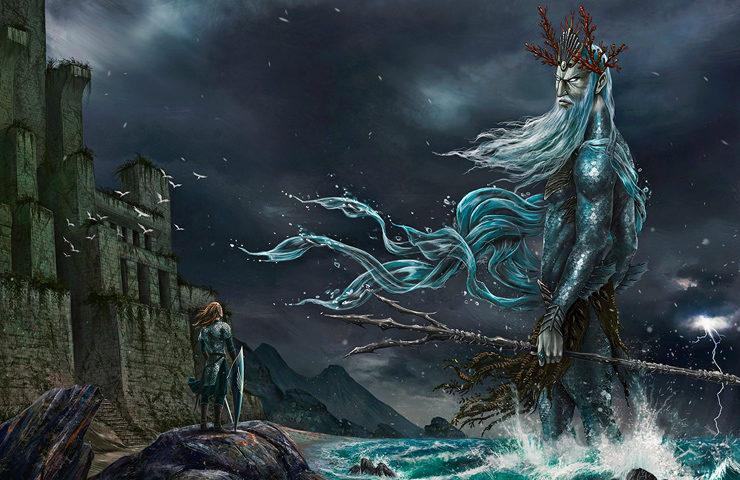In Which Tuor Takes a Littoral Walking Tour, Ulmo Tells All, Gondolin Is Given An Eviction Notice, and Turgon Loves Too Well the Work of His Hands
Chapter 23 of The Silmarillion, “Of Tuor and the Fall of Gondolin,” introduces us to a young man every bit as heroic as fellow mortals Beren One-hand and Túrin Turambar, but he’s given far less page time. Yet Tuor’s role is vital; his descendants will include famous names like Elrond, lore-master of Rivendell, and Elrond’s brother, who also happens to be the founder of Númenor and the ancestor of Aragorn.
The story of the fall of Gondolin is the first of the three great tales that Tolkien dreamed up before the rest of Middle-earth—the other two being the Tale of Tinúviel (Beren and Lúthien) and the Tale of the Children of Húrin (Túrin Turambar, et al.). And geez, given that he was gunning for Gondolin’s downfall so early in his writing career, this secretive Elf-city never really had a chance, did it? More detailed, if not-as-internally-consistent accounts of Tuor’s story can be found in Unfinished Tales (“Of Tuor and his Coming to Gondolin”); The Book of Lost Tales, Part 2 (“The Fall of Gondolin”); and very soon, the stand-alone book that’s likely to contain all of the above, also called The Fall of Gondolin!
For Primer purposes, I’m sticking mostly with The Silmarillion’s more abridged account, sprinkled with a few bits from elsewhere in the aforementioned earlier accounts.
Dramatis personæ of note:
- Tuor – Man (technically a human, but raised by Elves), future mariner
- Ulmo – Vala, Lord of Waters, Middle-earth fanboy
- Voronwë – Half-breed Elf (½ Sinda, ½ Noldo), mariner of Gondolin
- Turgon – Noldo, proud High King
- Idril – Half-breed Elf (½ Noldo, ½ Vanya), clandestine excavator
- Maeglin – Half-breed Elf (½ Noldo, ½ Sinda), goth, turncoat
- Morgoth – Ex-Vala, chiefest and greatest of assholes
Of Tuor and the Fall of Gondolin
First, we have to go back in time a little bit. Just before Morwen sent her son away to be fostered in Doriath, her cousin gave birth to her own son: that was Tuor. But quite unlike Túrin, Tuor gets to know neither his mom, Rían, nor his dad, Huor. Mom left him as an infant with the Grey-elves of Hithlum, then went off and died upon the Hill of Slain, that huge pile-up of corpses thrown together right there on the plains of Anfauglith after the Battle of Unnumbered Tears. Somewhere in that mass grave was also Huor, who died shortly after speaking prophetic words to Turgon, the King of Gondolin, in that same war:
This I say to you, lord, with the eyes of death: though we part here for ever, and I shall not look on your white walls again, from you and from me a new star shall arise.
Well, this chapter connects us to who or what that “new star” is. In the meantime, it might help to bring up the family tree again so we know exactly where he’s come from. So this is what the extended family looks like for baby Tuor:
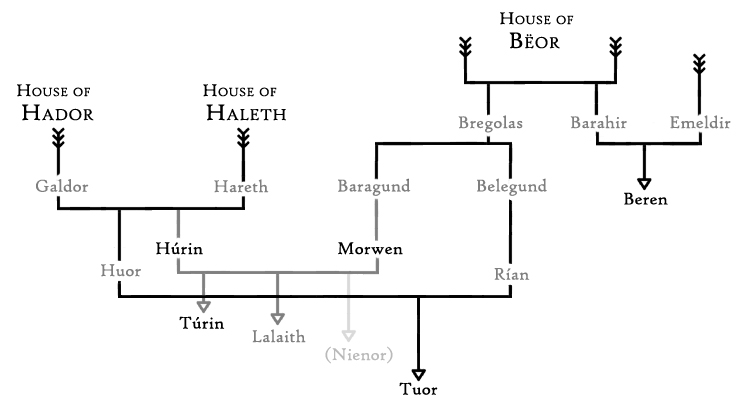
As we can see, Tuor and Túrin are first cousins. Will these two soon-to-be legendary sons of already famous dads of the House of Hador ever meet? Let’s find out.
Young Tuor, like Aragorn, is fostered among Elves after having lost his father to an Orc arrow in the eye! (Although at least Aragorn had his mom around for a good long while.) He has no mortal playmates, nor grown-ups of his own race watching over him—only the Sindar who live in hiding now that Morgoth’s got Beleriand in a stranglehold. This is in rather stark contrast to the early life of his cousin, Túrin, who after living with the people of Hador in freedom went on to live in the safety of Doriath. But then, there are a lot of differences between these cousins, not the least of which is that Tuor (a) is golden-haired, not dark-haired and (b) actually listens to the counsel of others.
We’re told that Ulmo, the Lord of the Waters, the primordial power who’s had Middle-earth’s back more than anyone, has chosen Tuor as his instrument. This is both generous of him but also audacious, since by and large the Valar do not meddle in the affairs of Men, or even in those of the Elves of Middle-earth. Ulmo’s a rebel among his own peers—the good kind of rogue Ainur. We know all about the bad kind.
Anyway, when Tuor reaches his sixteenth year, the Elves decide it’s time to get out of Easterling-occupied Hithlum and make for the small coastal havens founded by Círdan far to the south. (We’re not talking whole Elf-realms or strongholds, just the Sindar equivalent of hidey-holes, like a bunch of little baby Nargothronds, only able to exist at all because they’re tiny, they’re tucked away, and they’re far from Angband.) But before they get very far out the door, Orcs and Easterlings, who’ve been on the watch for these very Elves, attack! The Eldar are scattered, and Tuor is captured.
Buy the Book
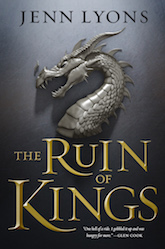

The Ruin of Kings
Then comes the second phase of his youth: thralldom. Tuor becomes a slave to Lorgan, the boss chief of all the Hithlum Easterlings. Suffice it to say this is a rough patch for our hero, but he weathers it. And after three years of servitude, hard labor, and being treated like shit by Lorgan, Tuor escapes! Unfinished Tales adds this fun little nugget:
The Easterlings hunted him with dogs, but without avail; for wellnigh all the hounds of Lorgan were his friends, and if they came up with him they would fawn upon him, and then run homeward at his command.
This immediately reminds me of Beren, who befriended beasts and birds in Dorthonion in his day. Well, Tuor’s mom was of the House of Bëor; this affinity for animals makes sense.
So Tuor returns to the caves where he used to live with the Grey-elves, and he uses it as his base of operations. He’s gone from boy to man and now he’s come into his full strength. So instead of trying again to head southward as the Sindar had intended, he is content to stay and live the outlaw life—the lonely but courageous Beren-like variety, as opposed to the selfish, hard-bitten variety of Neithan the Wronged (aka Túrin). And it’s in this phase of his life, from age nineteen through twenty-three, that Tuor enacts “such great hurt to the Easterlings that Lorgan set a price upon his head.” (Ah, now he’s got this in common with Luke of the House of Skywalker and Han of the House of Solo. Tuor is in good company.)
Tuor is valiant, but not ambitious (at least not when left to his own devices). In some ways, it’s this humility and down-to-earth heroism that sets him apart from both Beren (who hunted Orcs within sight of Thangorodrim and later entered Angband like some sort of Silmaril repo man) and Túrin (who arrogantly tried to take on Morgoth’s armies with brute force and sheer force of will). But Tuor is more obedient than those two, and a trace less vengeful, yet he’s still wise and makes good choices. He’s a loner like Ulmo himself, and he’s okay with it. And that’s why, I think, the Lord of Waters chooses him. Or rather, accounted for him.
Now we need to talk about Ulmo directly because, to paraphrase Corey Olsen, the Tolkien Professor, his fingerprints are all over this story. Going way back to the Ainulindalë, we were told that “of all most deeply was he instructed by Ilúvatar in music,” so he seems to be the most sensitive to the big picture. With his dominion being water, we’re then told in the Valaquenta…
And it is said by the Eldar that in water there lives yet the echo of the Music of the Ainur more than in any substance else that is in this Earth;
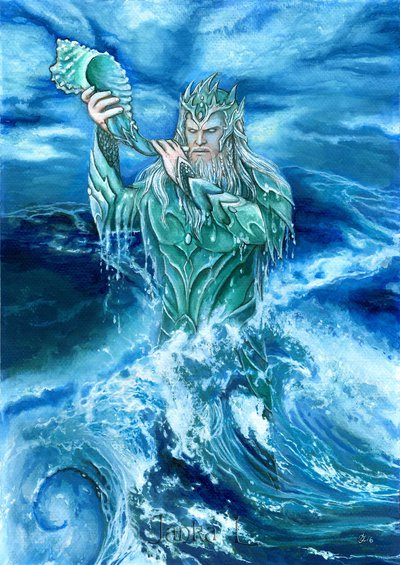
So Ulmo has a unique link to the Music through water, if not quite the the Manwë–Ilúvatar hotline the King of Arda seems to enjoy. He’s a strange sort of Vala, as he lives alone in the deep waters and only hangs with his co-workers when there are big matters to discuss. Yet he’s a chatterbox when you do meet him, and he just can’t get his fill of Middle-earth (and its rivers—don’t forget he’s got favorites!). Remember, he’s the guy who ferried the Nolder and Vanyar over to Valinor at the request of his peers (against his better judgement), then hung with the Teleri at the coasts of Middle-earth before bringing them over later. Yet later still, when the other Valar were all “we’d better not get involved with mortals,” he was the one who still tried to make contact with Men. Not face-to-face, but with messages sent “by stream and flood,” which didn’t really work. Their hearts were moved, but they weren’t configured to understand any of them.
Anyway, let’s get back to our hero. Tuor would probably have kept on leading the Robin Hood lifestyle indefinitely had Ulmo not actively stirred his heart to vamoose. The Vala straight-up places within Tuor the desire to…go west, young man! Tuor doesn’t know why he has this desire, at least not yet. I mean, it’s not like anyone’s ever come around with tracts to teach him about Ulmo. The Valar are just myths to Men, even the Elf-friends (aka the Edain). And it’s not like the Sindar who fostered him have any firsthand knowledge of the Lords of the West; they were never in Valinor, and it’s unlikely any of them were among the Eldar who met and first followed Oromë thousands of years ago.
Still, Tuor follows his Ulmo-driven instincts. He exits his Elven hermitage and crosses Hithlum, avoiding the Orcs and Easterlings who roam throughout. One day he spies a dark tunnel in the western hills called Annon-in-Gelydh, the Gate of the Noldor. It’s a secret passage that was carved by Turgon’s people in the days before they left that region by the coast called Nevrast. In the Unfinished Tales account, here Tuor encounters the same two Noldor messengers who were sent out by Círdan. They’ll end up reaching Nargothrond with the “Cast the stones of your pride into the loud river” warning. That message came from their lord, Círdan, who in turn got it directly from Ulmo.
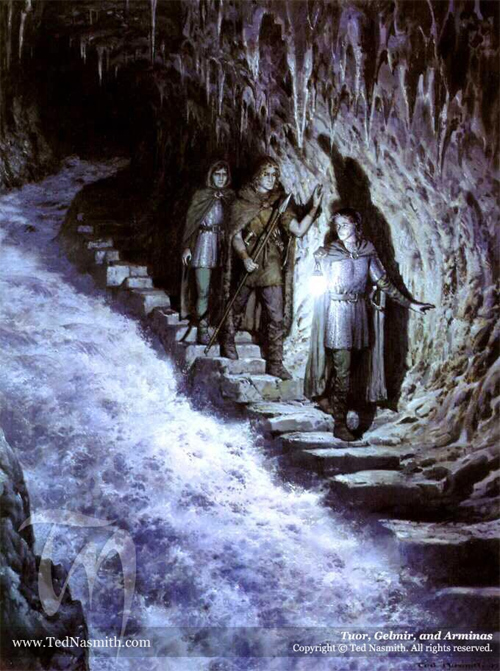
And it’s a pity The Silmarillion skips these messengers here, because they’re a helpful reminder that Ulmo has irons in several fires at any given time. (Well, figuratively speaking; more like he’s got many trawls in the sea.) Ulmo may have laid the most groundwork in Project “New Star” (i.e. his plans for Tuor’s line), but it sounds like he’s doing his best to help all the exiled Noldor as much as he can against the inevitability of a Morgoth victory. Remember, he’d given both Finrod and Turgon their city-building dreams in the first place, which in turn led to the founding of both Nargothrond and Gondolin. But even Ulmo knows that lasting is the best the Noldor can do. Remember what he’d told Turgon centuries ago: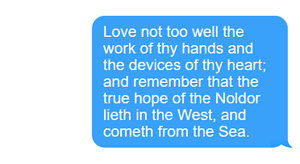
Right, so let’s get back to that true hope thread.
In refreshing contrast to Hurin’s own walking tour in the previous chapter, we’re told explicitly that Morgoth is completely unaware of Tuor and his departure from Hithlum. Not because they don’t know that there’s some outlaw hobo preying on the occupiers, just that neither Orc nor Easterling knows about this secret passage in the hills.
Tuor walks through the long and dark tunnel and emerges at last to a place he names Cirith Ninniach, the Rainbow Cleft. It’s a rocky pass through which headwaters flow toward the Sea until they become the Firth of Drengist. The name comes from the array of color produced by the foaming waters in the light of sunrise and sunset, but it’s funny that it’s Tuor himself, a Man, who gives it this name. Why? Well, like Buddy, he’s technically a human who was raised by Elves, so he’s no doubt developed a proclivity for naming everything.
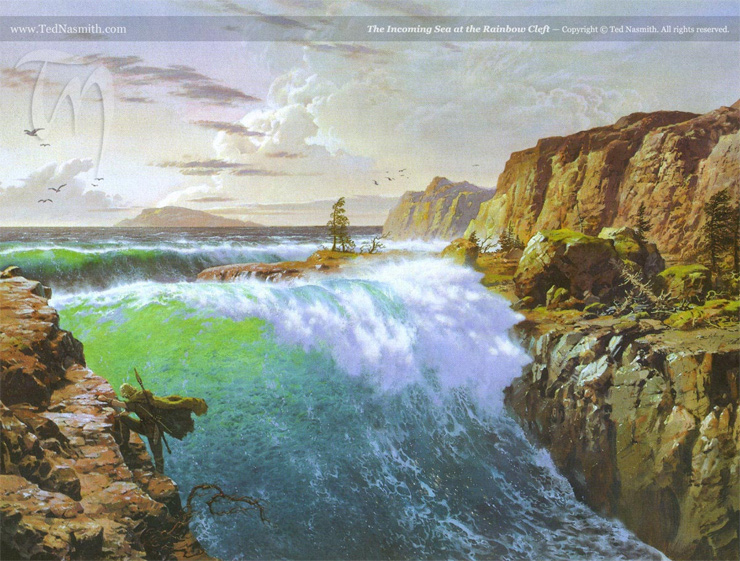
Now, Tuor is driven by divine inspiration, but he tarries on this journey like a freakin’ Teler. Taking his time, sightseeing nature, and loving everything. (Somewhere, Ulmo has got to tapping his waterproof watch.) When he reaches the actual coastline where the Firth of Drengist joins Belegaer, the Great Sea—not far from where Fëanor burned the ships and left Fingolfin’s host in the lurch—he enters the land called Nevrast.
The Sea itself inspires Tuor like nothing else. He is gobsmacked, thunderstruck, awestruck. He’s an immediate lifelong fan of the Sea at first sight, “and the sound of it and the longing for it were ever in his heart and ear.” It’s said that he was even the first mortal Man to look upon it, for none of the Edain ever came this far west. Basically, whatever happens from this point out, the Sea is in his heart.
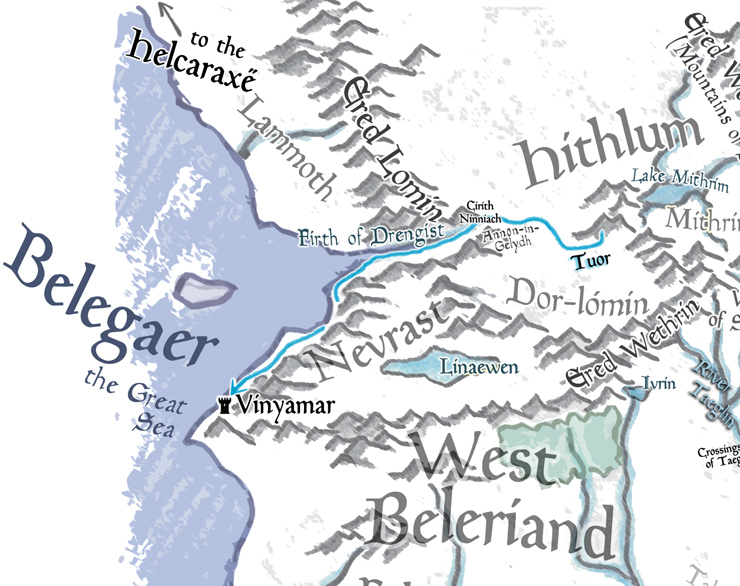
Tuor is in no rush, and he hangs out there at the coast of Nevrast for an entire summer and more. The narrator helpfully informs us at this point that at this same time far away, Nargothrond is about to fall. The First Age has known centuries of relative peace, but ever since the Battle of Sudden Flame forty years ago, things have been on a downward slide. Even as Tuor enjoys the lonely beauty of Nevrast by the sea, things are getting dire elsewhere. Then one day Tuor gets a sign: seven big swans flying south, which he rightly takes to mean “Get a move-on, Tuor!”
In Unfinished Tales, the swans even swoop down around him and make a big ruckus. Swans can be mean, and these seven are ginormous. But I also find this part of the story amusing. Oh sure, the Teleri can tarry for years and years and no one makes a stink, but a single Man lingers for a few months and it’s a whole big thing! Men always get shortchanged.
Following the swans, Tuor comes at last to Vinyamar, the old city where Turgon and his people dwelt in their pre-Gondolin days.
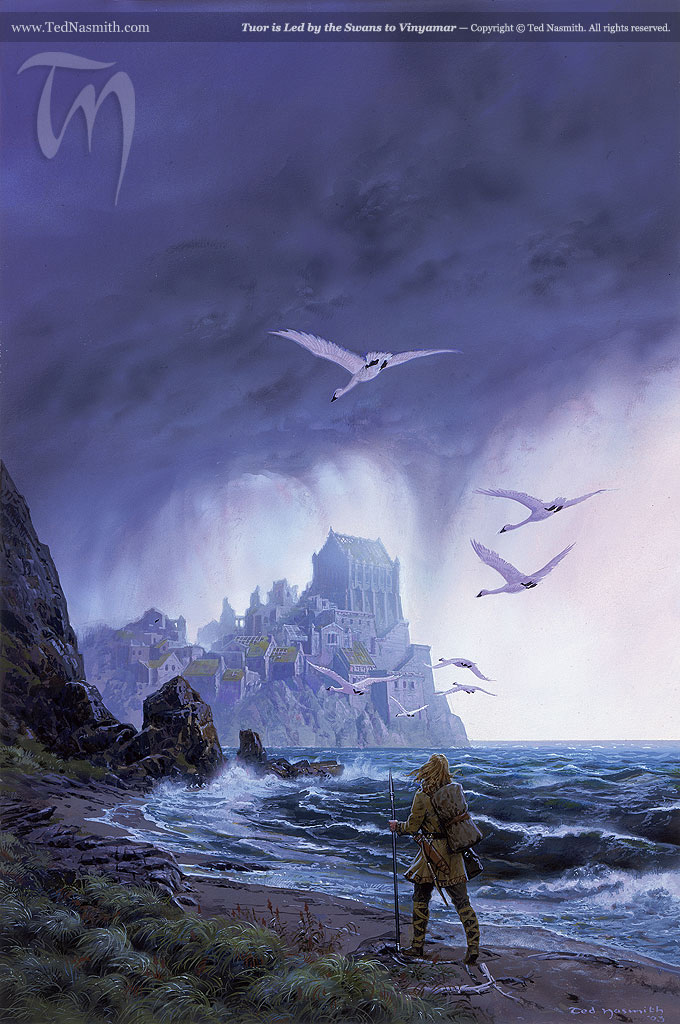
He explores the long-vacant settlement by the Sea, and before long he comes across a magnificent suit of chain mail (a hauberk), a helm, a shield, and sword, and it might as well be hanging on a mannequin (Man-nequin?) labeled “for one who shall come to warn Turgon, and from that one beyond ruin and fire hope shall be born.” For this is the very suit that Ulmo ordered Turgon to make, sized perfectly for the messenger who Ulmo’s been pushing for.
Understanding that this armor is important, if not why, Tuor puts it on then goes down to the beach. A storm rolls in from across the water, coming out of the west, and that’s when Ulmo finally steps out from behind the curtain to meet his chosen one—face to gigantic face. As a Vala who seldom assumes physical forms like his peers, on this occasion he does rise up from the waves “in majesty.” While The Silmarillion gives us nothing more than that, Unfinished Tales offers Tolkien’s earlier vision of him:
A tall crown he wore like silver, from which his long hair fell down as foam glimmering in the dusk; and as he cast back the grey mantle that hung about him like a mist, behold! he was clad in a gleaming coat, close-fitted as the mail of a mighty fish, and in a kirtle of deep green that flashed and flickered with sea-fire as he strode slowly towards the land.
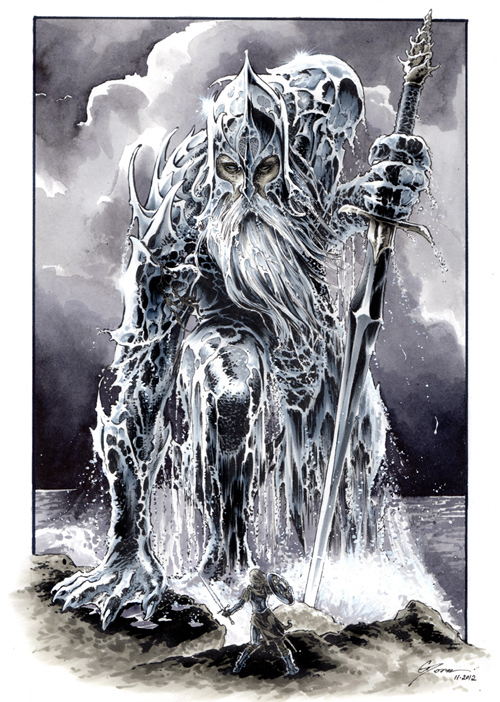
I know the whole chapter is awfully short considering all that transpires, but this particular section is painfully brief for such a momentous encounter. Ulmo lays it on Tuor, revealing what errand he has called him for: Tuor must go and find the Hidden City of Gondolin and bring Turgon a final warning. He gives him a special cloak that will help hide him on the journey; between that and the uncannily bespoke armor, Turgon is sure to know that this Man is Ulmo’s prophesied messenger.

Now, the Unfinished Tales account gives us nearly all of Ulmo’s words directly, and it’s full of great insight, concerning not just the quest he’s asking Tuor to accept—it’s requested of him, not forced upon him—but also plenty of context for what it all means. The Lord of Waters’ full speech is like an eloquently worded (because Tolkien) exposé on all things Eldar. Chatty Cathy that he is, Ulmo dishes about things no mortal has ever heard before, least of all from a Vala. We’re talking the Two Trees, the Darkening of Valinor, the Exile of the Noldor, the Curse of Mandos, you name it. (Probably even the Leap of Beren!) The guy kinda just won’t shut up.
Thus is Tuor informed like no other Man. And all straight from the (sea)horse’s mouth. What stands out to me the most is Ulmo’s admission to Tuor that he, Ulmo, is “a secret voice that gainsayeth” even the other Valar—or rather, that it’s kind of his job to oppose the will of his peers at times, and that he was appointed to do so before “the making of the World.” I can’t help but feel like Ulmo’s had all this bottled up a while and needed to tell someone. So why not his new favorite mortal?
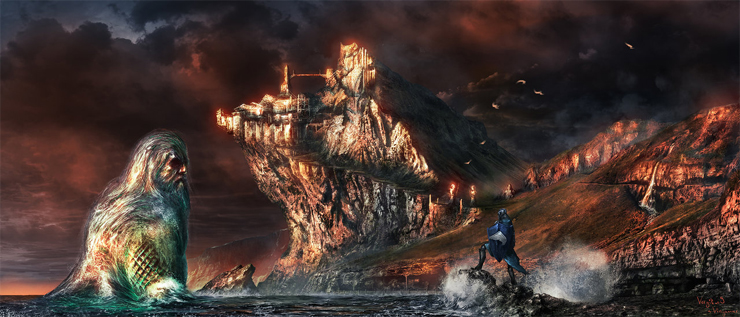
But sheesh, what a mindjob! And Tuor takes it all in stride. So why, one might wonder, doesn’t Ulmo do more than just talk to Tuor and send him as a messenger? Why doesn’t he go to Gondolin himself, or use his rivers and waters to foil Morgoth? You get the sense that he would if he could, and he’s definitely exercised his power in and around the Vale of Sirion plenty of times in the past, as well as at the Pools of Ivrin. But he admits that Morgoth’s power has grown and that Ulmo’s has diminished wherever the Dark Lord’s minions have defiled these waters (like nasty old Glaurung had).
The next day after his meeting with Ulmo, Tuor meets an Elf by the name of Voronwë who’s hanging out by Vinyamar’s vacant sea-facing wall. And he is totally that one surviving mariner that Turgon had sent out after the Battle of Unnumbered Tears, seeking Ulmo’s “true hope” that “lieth in the west.” Spared from the wrath of Ossë by Ulmo himself, Voronwë never did go back home to Gondolin. He’s strayed and tarried by the shores (as you do) for some twenty years and is somewhat ambivalent about the Sea now. He’s just sort of haunting the coast near Vinyamar like he’s waiting to fulfill a purpose….
When you know more of Voronwë’s story from Unfinished Tales, it’s a bit heartbreaking. Not only has Voronwë suffered hardship and loss, he’s fallen behind the times. When he meets Tuor, not only is he amazed to see a Man so arrayed in princely Noldorin armor and claiming to have just met Ulmo, Voronwë dares to hope that things are better now since he’s been away.
‘Long have I labored in the unrelenting sea. Tell me: have great tidings befallen since I walked the land? Is the Shadow overthrown? Have the Hidden People come forth?’
‘Nay,’ Tuor answered. ‘The Shadow lengthens, and the Hidden remain hid.’
You know you’re out of the loop when a mortal hermit is the one to fill you in. But actually, nah, Tuor has inside information now. And Voronwë rolls with it. I mean, no one just ups and claims to have met Ulmo the Mighty unless it really happened. He agrees to lead Tuor to Gondolin but also tells him that, by Turgon’s own laws, there’s no way they’re just going to let a mortal Man in. But Tuor’s politely all, “Hello? Messenger of Ulmo here, sporting the hauberk and helm that Turgon himself commissioned? He’ll have to let me in.” But I’m paraphrasing.
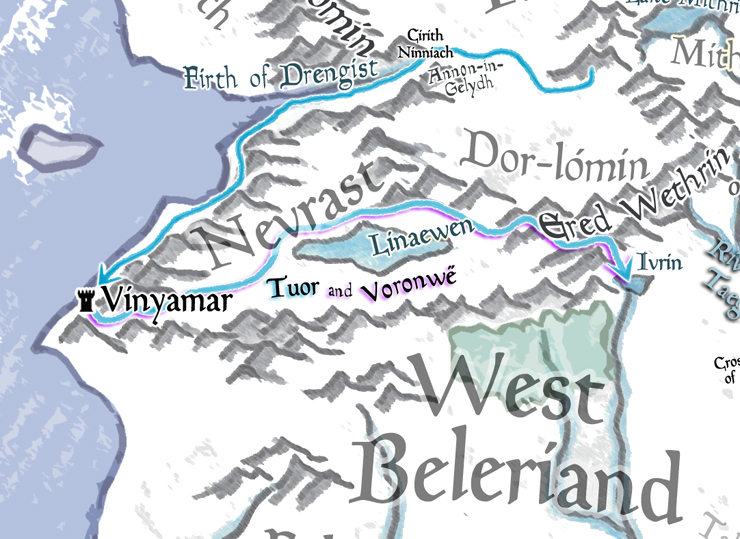
They journey together back to the east, following along the Mountains of Shadow. This is during that especially fell winter that Morgoth unleashed on the land after Nargothrond’s ruin. Tuor and Voronwë arrive at the Pools of Ivrim, those springs that were once blessed by Ulmo, only to discover that it’s all frozen and fouled up. Which is, of course, the work of the Dragon of Angband, Glaurung, who’d defiled the place like a rock star trashes a hotel room. It’s here in this frigid mire that Tuor and Voronwë spot another traveler hiking past in a different direction: a Man with an interesting black sword. But the guy is oblivious to them, hurrying north, and seems to be dealing with some shit.
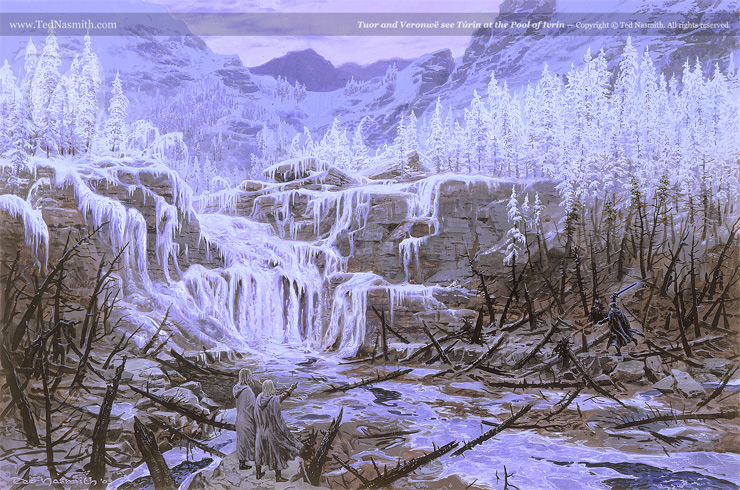
What up, Cuz?
But no, they let the mysterious, dark-haired man go on without bothering him (and we barely dodge a crossover episode!). Which is probably a very, very good thing for our two travelers. Wouldn’t want to see something bad happen to poor Voronwë, for example. Túrin Turambar has a bad track record with Elven friends. Accidents happen.
So on they continue through the harsh winter, across the Vale of Sirion and many Orc-infested miles. Tuor’s got his shadowy Ulmo-cloak, and Voronwë is naturally stealthy. At last the Encircling Mountains rise before them. Had Tuor not procrastinated in Nevrast before reaching Vinyamar where Ulmo waited for him, he’d have started on this journey much sooner and gotten ahead of this season of death. Ulmo had even said as much to him:
Haste thou must learn, and the pleasant road that I designed for thee must be changed. For my counsels have been scorned, and a great evil creeps upon the Valley of Sirion, and already a host of foes is come between thee and thy goal.
Lest we think that even an obedient goody-two-shoes mortal is just strolling easily along a predetermined path of destiny. Ulmo may have attempted to roll out a fate-lined red carpet for Tuor, but being a Man, Tuor’s kind of screwed that up. How aggravatingly human Tolkien’s Men are, and how slippery their free will!
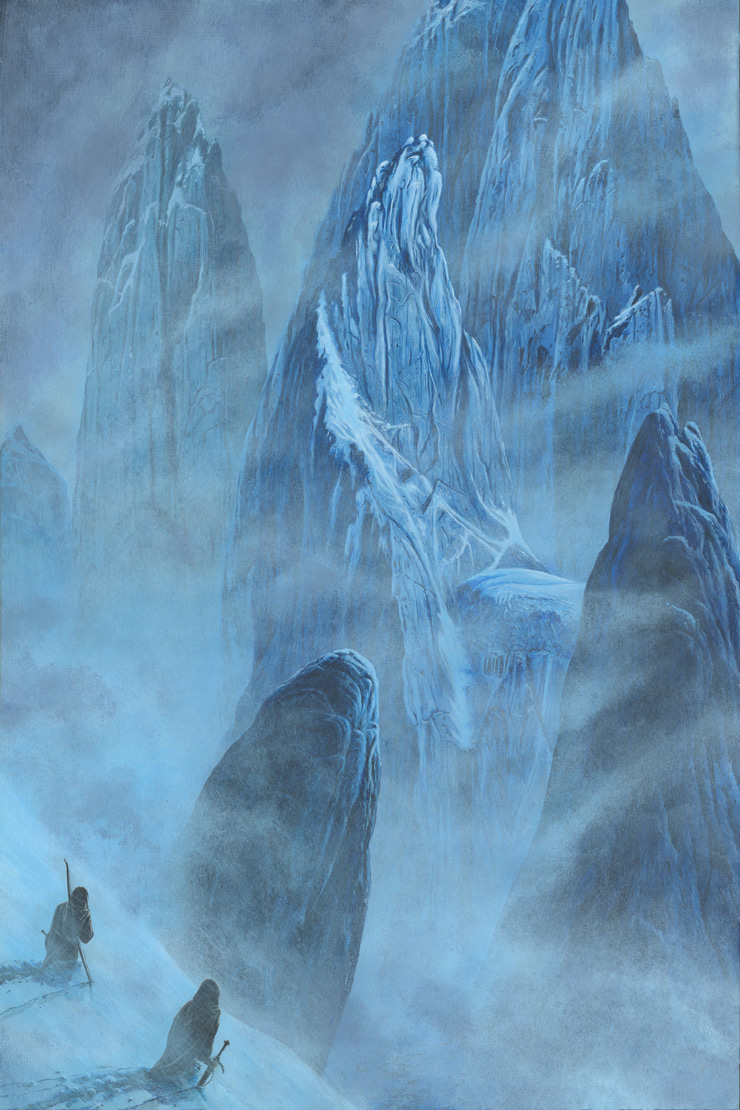
And then the day comes at last. Voronwë leads them to the secret entrance in the Echoriath, the Encircling Mountains, where Gondolin’s hidden sentries take them in like well-treated prisoners. Once you’ve discovered the way in, there’s no going out again.
The gate-wardens are surprised to see a Man at their doorstep, but they quickly realize this one’s business has a capital B. Not only is he wearing storied Elf-togs, a cool shadow-cloak, and a Noldorin sword, but he claims to be the son of Huor, one of the two mortals who had actually come to (and somehow managed to leave from) Gondolin years ago.
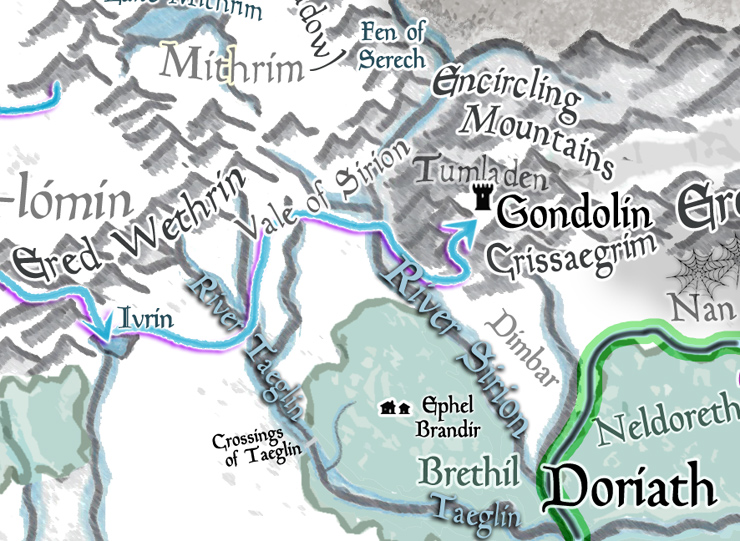
And this is where Tuor and his ex-mariner Elf-guide are escorted through a long ravine with seven über-cool gates, none of which get any mention in The Silmarillion—but Unfinished Tales can hook you up with the details. They’re seven fortifications of wood, stone, bronze, iron, silver, gold, and steel, illustrious yet formidable gates an army would have a hell of time getting through, even if they found a way in through the mountains.
Tuor finally gets a look at the Hidden Valley and its amazing centerpiece, the glorious city of white stone that was constructed in memory of the Noldor’s first city of Tirion back in ancient Valinor. The captain and gate-warden, Ecthelion of the Fountain, whom we first saw in action guarding the retreat of his king in the Battle of Unnumbered Tears, orders a blast of trumpets that is then echoed back from the walls of the city. I assume he’s got some signal system in place, and this particular sequence might mean FYI, A Serious VIP Has Been Admitted.
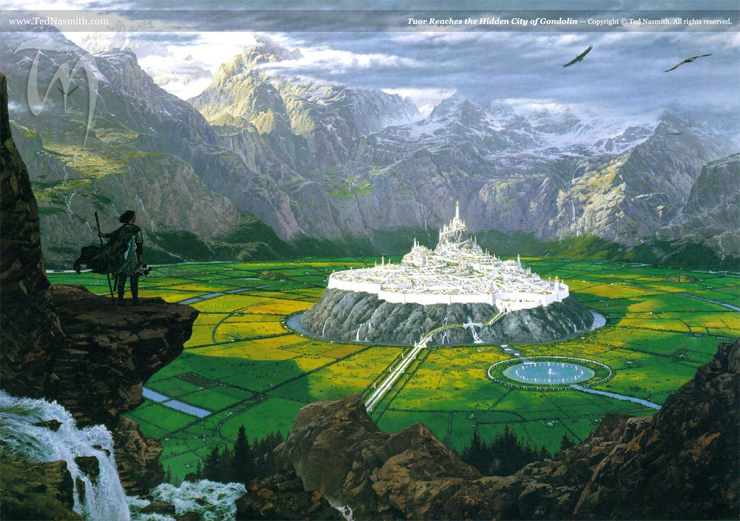
Across the fields and up many stairs, Tuor is escorted into the city. There are shining fountains all over the place. This place is fair indeed! Then he comes to the Tower of the King, the centerpiece of Gondolin, where he sees images carved depicting the Trees of Valinor. (Hey, Ulmo told him about those!) Then he’s brought before the throne of Turgon, High King of the Noldor, who has got to be holding his staff of doom like a mofo in this moment.
And though we’re not explicitly told this here in the text, Turgon’s got a memorable sword that’s surely hanging from his hip right now. Thousands of years in the future, Tuor’s own grandson will say:
This, Gandalf, was Glamdring, Foe-hammer that the king of Gondolin once wore.
Also present is Turgon’s daughter, Idril, “fairer than all the wonders of Gondolin.” And also Turgon’s nephew, Maeglin. Remember these two? This is also a good time to remember the tale of Maeglin’s dysfunctional family.
Now that Tuor’s long journey is at an end, he relays his warning to Turgon, which was seemingly the purpose of his coming. And it’s basically: hey, remember the curse of Mandos and the Prophecy of the North? It’s reaching a head. The works of the Noldor are not going to last, Turgon, so it’s time to make like an Ent and leave. Follow Sirion down to the Sea…and survive! Thus spake Ulmo.
Now, Turgon remembers what Ulmo told him. I have think that he’d have had it cross-stitched and framed and hanging on his foyer wall by now. It was the final take-away from his own conversations with the Lord of Waters, after all.
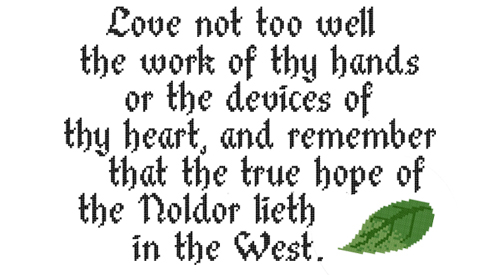
Plus, the arrival of Tuor in that signature armor gives him pause. This young mortal is obviously important. And Turgon also remembers the seemingly prophetic words of Huor, the guy’s own dad, about a “new star” arising somehow from the two of them (Huor and Turgon). So this Tuor fellow needs to be well cared for. He’s practically family.
But you know who doesn’t care one bit for this magical mystery Tuor, nor his heritage, his message, and his insta-favor with the King? Not one tiny bit? Maeglin, of course! All these years later, the half-Noldo-half-Sinda still has the hots for Idril, but he especially wants the throne she surely comes with. Maeglin hadn’t liked Huor when he visited; he sure as heckfire doesn’t like his snot-nosed kid. So the creepy son of Eöl—you know, the Dark Elf who was executed here in Gondolin more than a century ago for the murder of Maeglin’s own mom—makes sure to oppose Tuor in all counsels. And Turgon does listen to what everyone has to say, and he thinks hard about what to do.
Now, this is the pivotal moment for Gondolin and probably all of Beleriand. Turgon considers all he’s gone through up to this point: all the years of labor in building Gondolin, all the shade he might have been thrown for his unswerving laws, and the ever-searching malice of Morgoth, who he has managed thus far to elude. And so Turgon decides that Gondolin is strong enough to hold against Morgoth “though even a Vala should gainsay it,” and that its secrecy makes it unassailable. But what if I really, really, really love well the work of my own hands, Ulmo? Have you considered that? Gondolin’s doing fine, but thank you very much for your concern, old buddy. We got this.
Turgon has become far too proud to just cash in fair Gondolin’s chips now. Yet he was there when the Doom of Mandos was pronounced, and remembers well Ulmo’s warning that it would find him eventually, and that treason shall “awake within thy walls.” And so, as if he can simply wall up fate, Turgon has that outer secret door (the one Voronwë led Tuor to) blocked up; it’s no longer enough that it’s just hidden. Now there’s no more going outside the valley with messengers or scouts. For anybody. This is a total quarantine situation now. Turgon, like many ill-fated leaders in the past, goes all isolationist. Gondolin first!
And the fact is, things are fine for some years after this point. Things are okay. Tuor can’t change the mind of Turgon, so he stays and lives in Gondolin (as if leaving were even an option). But he becomes enamored of its people, their culture, and their wisdom (the current wisdom of the king notwithstanding). All of his already heroic skills are honed in the presence of so many Noldor. And others—even before Gondolin, Turgon’s people mixed with Sindar. Voronwë himself came from such intermarrying Elves.
More importantly, Idril falls for Tuor, and he falls for her. Their romance, while seemingly understated in the narrative, certainly portends many events and people to come. Whereas every other time the union of a Man and an Elf is a huge deal—Beren had to get a Silmaril, Aragorn will have to unite kingdoms and bring down Sauron—Turgon is immediately okay with his daughter marrying Tuor (he’s become fond of the chap). But mostly it’s because of that “new star” prophecy. Good on you, Dad!
Celebrations are made as Tuor and Idril tie the knot, and now we have “the second union of Elves and Men.” In the year 503 since the arrival of the Noldor on Middle-earth and the rising of the Moon and Sun, they have a baby: Eärendil. Now, we’ve received a few hints about the significance of this Eärendil the Blessed in the past, but he is the one Huor’s soothsaying referenced. And he’s why, even though Turgon has shrugged off Ulmo’s warning, Tuor’s coming to Gondolin is still important.
So in little Eärendil (ay-ah-REN-dil) we’ve got the blood of the Noldor mixing in with the three houses of the Edain. He’s the ultimate Mutt of Ilúvatar!
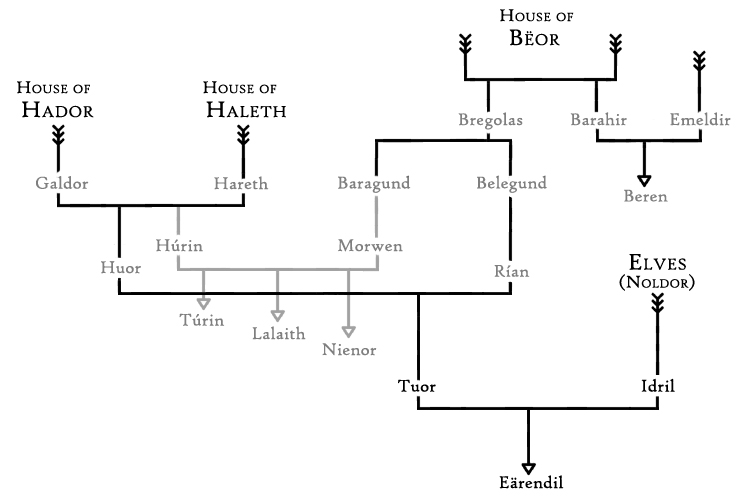
In any case, now Maeglin is really pissed. Tuor has removed his hopes for both Idril and the throne. Pride and jealousy seethe within him, which certainly doesn’t bode well.
Speaking of pride and jealousy, we cut over to Morgoth, who around this point in time has been busy grinning over the murder of Thingol, the departure of Melian and her Girdle, and then the death of the last king in Menegroth, Dior, and the destruction of all of Doriath itself. Two of the most elusive Elf-realms, Nargothrond and Doriath, have now fallen. He’s seriously jonesing now for Gondolin’s ruin.
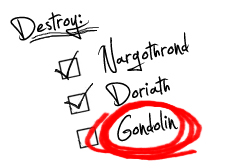
He even knows roughly where it is, now: somewhere around the Encircling Mountains where Húrin had called out for Turgon. But every time he sends Orcs in to poke around that region, those Manwë-be-damned Eagles pick them off (then possibly pick their bones). No one can report back to him. So Morgoth’s still biding his time, trying to figure out a way to crack that shell. It’s so close—almost hidden in plain sight!
Meanwhile, two things are taking place without the knowledge and against the will of Turgon, High King of the Noldor. The actions, rather, of two people.
Let’s start with Idril. We’re told that the Gondolindrim princess was “wise and far-seeing,” as many royal women in Middle-earth seem to be. While nearly everyone within Gondolin is enjoying peace, she is troubled and forsees evil to come. So she devises a secret escape route out of the hidden valley, letting only a select few in on this contingency plan (probably only those who help her tunnel it out). No way would her daddy approve this; he’d consider any way out to be a way in. But she’s a clever girl and knows what needs doing. And note, by the way, that she’s not just helping someone else. This project is all her—it’s not even clear that she lets her husband, Tuor, in on this until the day the secret way is actually needed. Idril may be the daughter of the King, but she’s not some pampered Disney princess. Idril’s a Calaquendi Elf, born in Valinor, who survived the march with her kin across the Helcaraxë, on foot, and in that frozen hellscape lost her mother. Idril’s tough, and now she’s overseeing some surgical excavations on the down-low. Pretty badass.
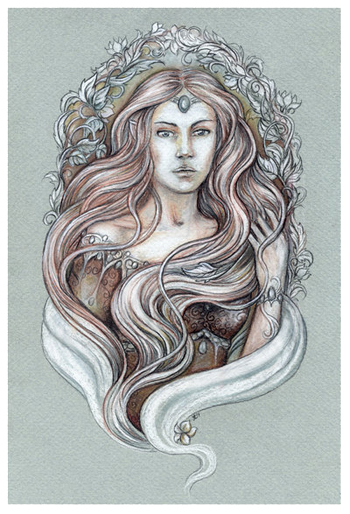
Then there’s Maeglin, Idril’s sinister cousin, who in the past has often gone out into the mountains in search of metals to mine for his smithwork—which is all well and good by itself. It was even his craftsmanship that helped the Gondolindrim warriors when “Turgon opened the leaguer of Gondolin” and marched out with ten thousand at the Battle of Unnumbered Tears. But whatever points he may have stacked up from his martial contributions are about to be sold out with interest.
See, he starts going even further afield into the mountains than usual, venturing beyond the boundaries laid own by Turgon’s laws. He takes to going out with even less company, or even alone, not unlike…say….Fëanor and his sons back in Aman….or Melkor himself in the Void. Well, one day, “as fate willed,” Maeglin runs into some Orcs and they manage to snatch him up. An Elf fresh from Gondolin, probably still smelling of the hidden valley beneath all that mining dust. A prize indeed! The Orcs drag him back to Angband in chains and he is tortured, if not maimed. He’s Moriquendi, but he still toughs it out. Yet Morgoth proposes a bargain between the two of them, and Maeglin accepts it. Thus does Maeglin fulfill the warnings from long ago about treachery awakening within Turgon’s walls. Even worse, this is the first time any of the Firstborn Children of Ilúvatar has ever allied with Morgoth since…well, since he’s been Morgoth, the Dark Enemy of the World. Even Fëanor would not have done this.
But alas. Mandos called it. Ulmo called it: the treachery is coming from inside the Hidden City!
Peril draweth nigh indeed. Maeglin has ratted Gondolin out, and for it Morgoth promises him the lordship of Gondolin once it’s been taken. Hey, look, Morgoth’s made another promise! But this time I’m sure he’ll keep it. Definitely, definitely.
And just in case anyone wants to give Maeglin the benefit of the doubt, or figure he’s just stuck in a bad situation—and yeah, being captive in the Iron Hell that is Angband is a terrible predicament—Morgoth lets him return to Gondolin so as not to arouse suspicion. And so that Maeglin can strategize from the inside. But right there in his uncle’s court, with ample opportunity to renege on Morgoth’s deal, he stands “with smiling face and evil in his heart.” He’s crossed over to true villainy. There’s no second-guessing this. Maeglin is in bed with Balrogs who would tear Elf toddlers apart.
Speaking of Elf children, it’s after little Eärendil has turned seven that Morgoth makes his move. He’s gathered his armies for a single-minded, brutal assault. Balrogs, wolves, and Orcs aplenty set out from Angband, followed by numerous dragons of Glaurung’s brood. The fire-drakes still can’t fly, but they sure can traverse mountains. This army of darkness comes from the north, flowing over the hills and mountains during a “time of festival” (a Morgoth classic!) in Gondolin. Going nowhere near the original hidden door and the seven magnificent gates.
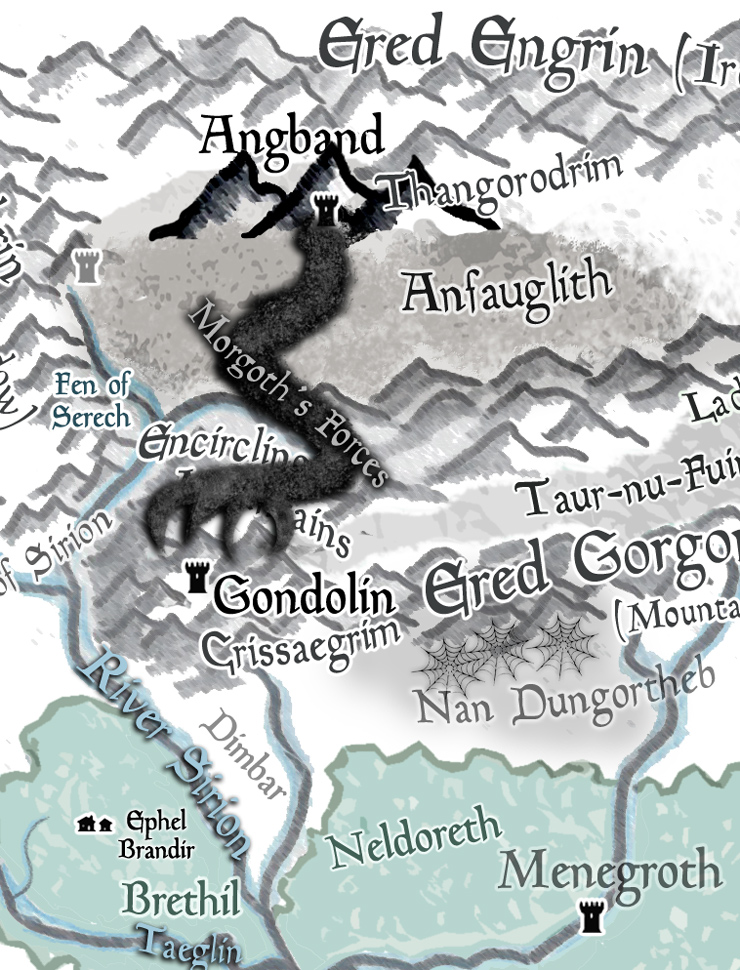
Now, I don’t know where the Eagles are at this point. Why don’t they spot the massive army of monsters and give Turgon warning? We’re just not told. Given the brief wording of all of this, we could simply chalk this up to Maeglin’s helping out from the inside and making sure the day chosen is a day the Eagles aren’t around. Who says they monitor the skies around Tumladen 24/7? Maybe Thorondor and his subjects happened to be away that weekend at CloudCon or something.
So it’s not until the forces of Morgoth have come pouring down the north end of the valley that Gondolin’s people take notice of them and start to mount a defense. But this is an overwhelming tide of Orcs, Balrogs, wolves, dragons, and who knows what else; I mean, are there trolls!?! We got barely a glimpse a few chapters back. Either way, the city is in serious trouble. The enemies climb and crawl up the hill and over the city’s high walls. The dragons could even have some form of proto-wings at this point—Morgoth is still working to breed those in somehow—but they can’t fly yet. Yet that fact hardly limits their strength and size, nor their devastating fire. They coil about the towers and bring them crashing down. This isn’t seizure, it’s destruction.
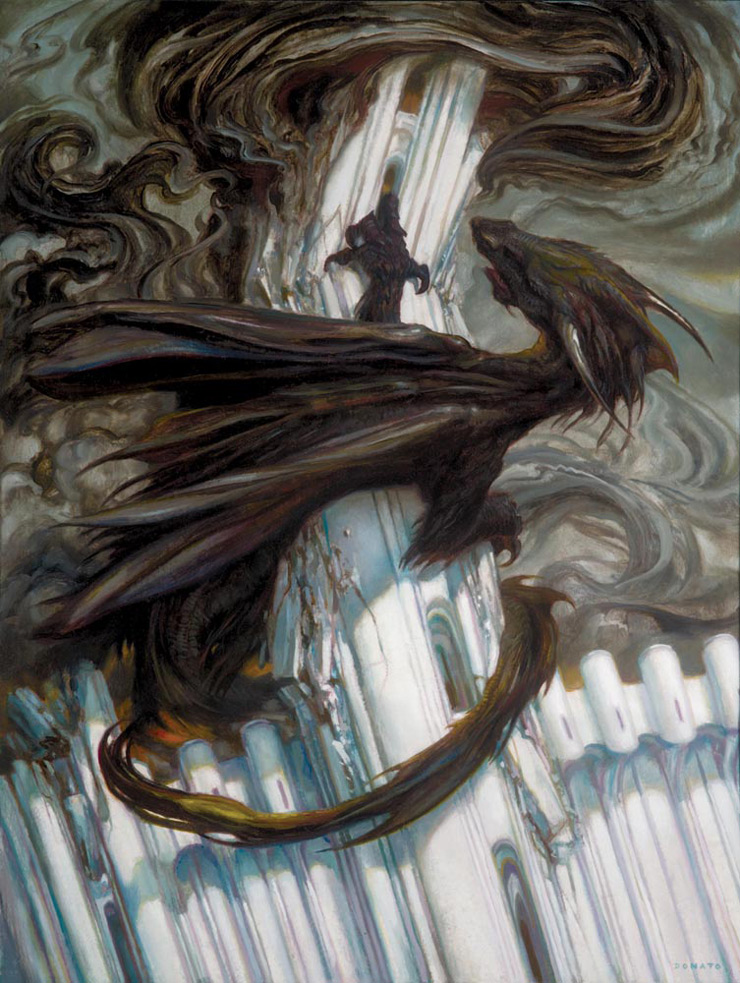
And there’s just no stopping this tide of evil. There is only, at best, surviving it. We’re given only the briefest of highlights of this devastating siege, a massive contrast to the scads of details The Book of Lost Tales, Part Two gives us, but it’s important to note that in that earlier account, there are elements not stylistically compatible with Tolkien’s later vision of Middle-earth. One fascinating example: In that version, Morgoth sends not only his living minions but also mechanical “monsters such as have only at that time been seen and shall not again,” constructs of iron, copper, and bronze that seemed to combine both siege engine and transport for not only Orcs but also Balrogs. We’re talking Middle-earthen tanks and armored personnel-carriers. Still, there’s no mention of such monstrosities in The Silmarillion.
But we are told that Ecthelion of the Fountain squares off in the King’s square against Gothmog himself—the evil Maia responsible for the death of Turgon’s elder brother, Fingon, and who brought low the great Fëanor long before. The valorous Elf captain takes down the Lord of Balrogs single-handedly like the Calaquendi boss that he is, though he gives up his own life to achieve this victory (a fact that Tolkien actually “spoiled” for us many, many chapters ago).
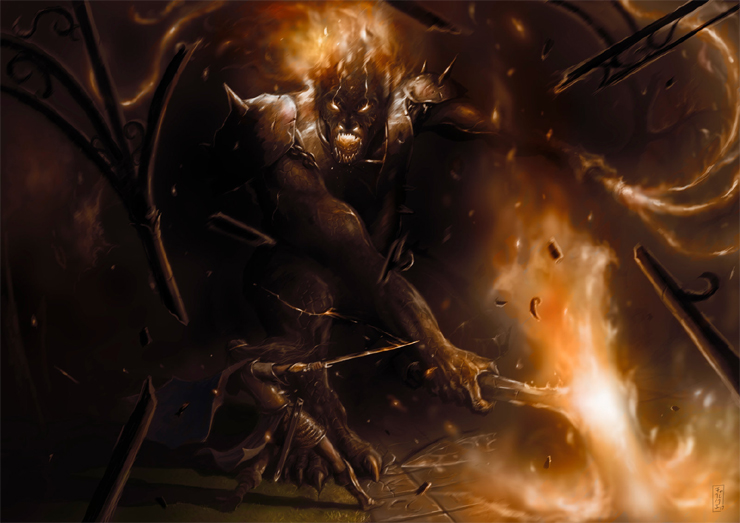
Going back to The Book of Lost Tales, Ecthelion’s feat actually involves him impaling the Balrog in the chest with his spiked helm, grappling and pulling them both down into the square’s deep fountain, Gandalf-style;
and Ecthelion sank steel-laden into the depths, and so perished the lord of the Fountain after fiery battle in cool waters.

A very metal death indeed!
The King’s own palatial estate is then defended by its household guard, and by Turgon himself at the pinnacle, but to no avail. The entire tower comes crashing down, with the king inside, as others look on. Turgon is slain not in hand-to-hand combat, but in the building’s collapse…
and mighty was its fall and the fall of Turgon in its ruin.
Yet he goes down fighting, like everyone who dies in this battle. The Book of Lost Tales even has him finally admitting Gondolin is a loss, consenting to the flight of Tuor and Idril with as many as they can take with them. But Turgon himself chooses to stay and keep fighting, like a captain going down with his ship. He casts away his crown as if in abdication, and calls out victory for the Noldor to spite the gathering Orcs. But ultimately, multiple dragons tear at the base of his tower and it crumbles “with a great clangour.”
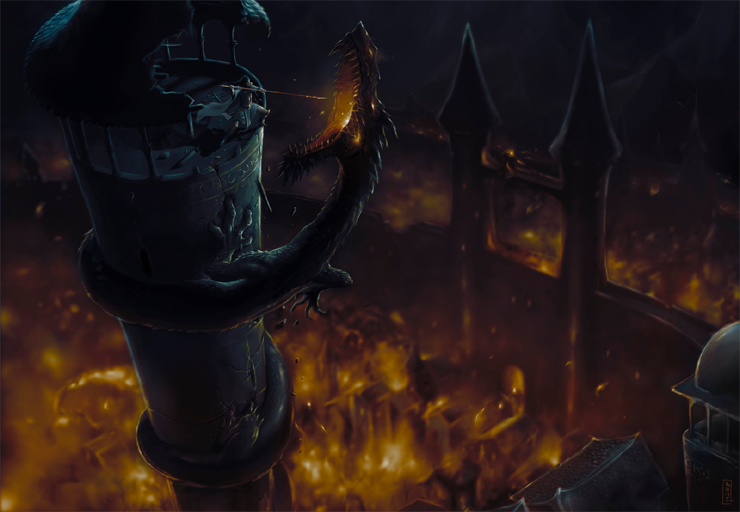
Too well did Turgon love the work of his hands and the devices of his heart. But though all his people are in dire straits, his own spirit is loosed to return to the Halls of Mandos and Valinor, where he can at least be reunited with his wife, who perished in the crossing of the Helcaraxë. It’s been more than five hundred years since he’s seen her.
And oh, now he’ll get to see his sister, Aredhel, again. There’s so much to talk about….
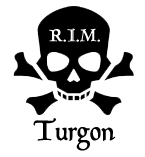
But we’re not done yet! Battle rages on in the Not So Hidden Valley.
At the time of the start of the siege, Tuor was not with his wife and son. He now has to fight his way to them, only to find that they’re being manhandled (Elfhandled?) by the dastardly Maeglin—toward whatever fate he’d intended for them. The Book of Lost Tales account does not let us wonder: he drags Idril by the hair, intent on making her watch him cast her son, Eärendil, over the battlements and into flames below. Maeglin has truly eclipsed his own father now.
And yet, it takes one to know one: Maeglin surely sees by now that Morgoth is an inimical asshole and liar. What good is being the lord of Gondolin if the city itself is busted up and defiled by the monsters of Angband? Its spires are being torn down, its streets cracked, its fountains broken, its people roasted and slain. Sucks to be Maeglin right about now, yet frankly, I think he deserves little pity. There’s no victory on the table for him—only repentance, at best, which he doesn’t even seek.
Tuor reaches Maeglin on the high walls and they do battle, the former no doubt clad in Ulmo’s hauberk of righteousness and the latter armored in Eöl-black. “Here shall you fail of all your hopes,” Maeglin’s dad had said to him with his prophetic final words, “and here may you yet die the same death as I.” Tuor fulfills the Dark Elf’s prediction for him: he gets hold of Maeglin and hurls him out over the wall, where the Elf not only bangs against the cliff as he falls, but then drops down “into the flames below,” flames which his own lustful dreams of power had brought to this city.

I imagine the spirit of Eöl is there waiting for him in the Halls of Mandos, such that the first thing the bodiless Elf perceives is the mocking and slow clap of his father. “Did I call it or what, son?”
Tuor’s got his wife and kid back now, but at this point, it’s all just damage control. Tuor and Idril together take charge and gather up “such remnants of the people of Gondolin” as they can find in the chaos and death around them. With them is that other notable captain, yellow-haired Glorfindel—who is absolutely the same Glorfindel who meets Strider and the hobbits on the road to Rivendell and helps to ward off the Ringwraiths thousands of years from now. He’s the one who Frodo sees as a “white figure that shone,” seeing him, as Gandalf explains, “as he is upon the other side.” Other side of what? Well, read on.
Now does Idril’s preparedness come into play: she and her husband lead the people through that passage at the northern end of the valley that leads into the mountains. And much like sneaking the One Ring into Mordor will one day be a great surprise to Sauron, here no one would have guessed a secret exit would go out northward towards Angband. Boy, does she ever deserve a Surreptitious Escape Route merit badge for this moment: Idril’s secret passage is secret! In fact, the steam of Gondolin’s many fountains amidst all the burning provides the escapees the very smokescreen they need to flee to safety.
Turgon is dead, and the dream city fashioned in the memory of Tirion is utterly ruined.
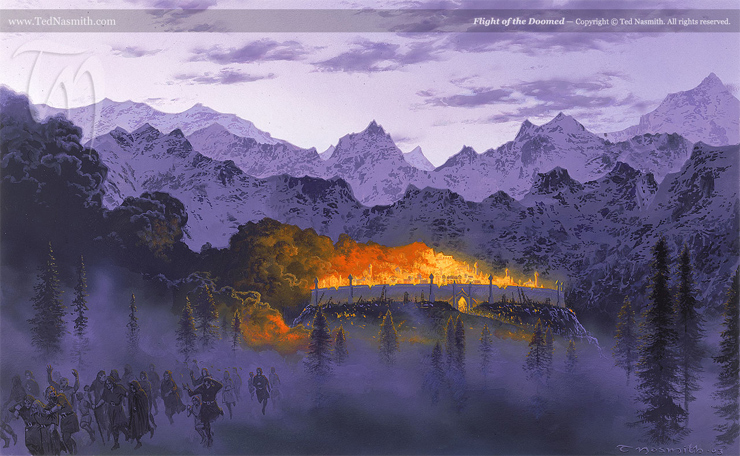
But Idril’s secret way out isn’t an easy one.
Nonetheless they came hither, and beyond hope they climbed, in woe and misery, for the high places were cold and terrible, and they had among them many that were wounded, and women and children.
Seven-year-old Eärendil is among these, too. Soon the refugees come to an especially narrow and deadly pass, with a sheer wall of mountain on one side and a whole lot of open sky on the other. And this is when we discover that Morgoth held back a portion of his army in watchful reserve: a whole swarm of Orcs and one Balrog were placed in the hills around this region on the off-chance that any Elves manage to sneak out. So now they’re in real trouble. The refugees are already weak.
And that’s when valiant Glorfindel takes one for the team. Not just because he presents himself as the Balrog’s target, drawing it away from his people, but because he’s a badass warrior and he can actually deal out some hurt to this Scourge of Fire. He duels the great demon of fire upon a pinnacle of rock and in their epic battle, he takes it down with him into the abyss, Gandalf-style.
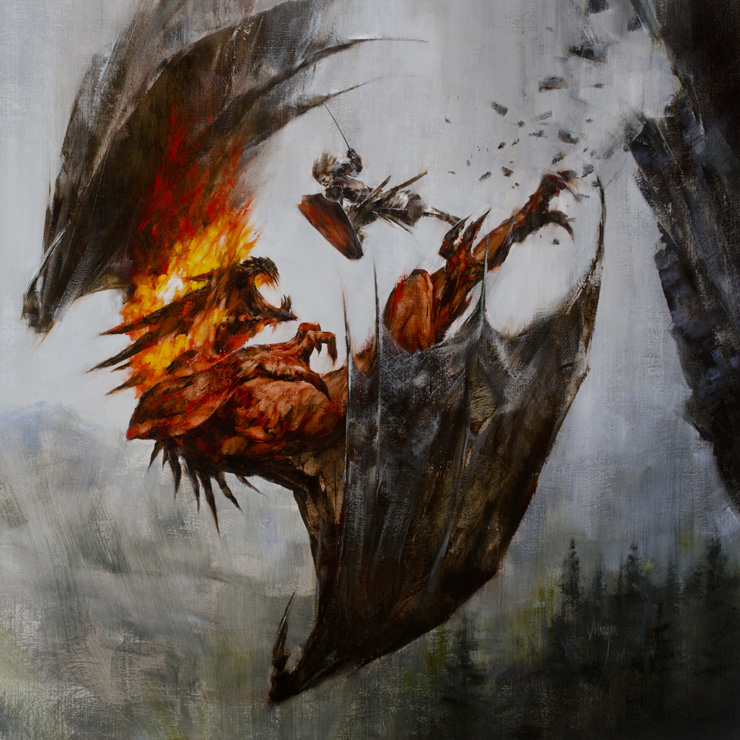
Your wings (if you even have any) will not avail you, flame of Udûn (Sindarin for “hell”)!
But yeah, Glorfindel essentially pulls the first “fly, you fools” moment (long before it was cool), taking on a Balrog in a narrow place and sacrificing his own life to save everyone else. Considering that Glorfindel is one of the very few known Elves to be re-embodied in the Halls of Mandos and will actually be sent back to Middle-earth later, the Maia who will someday be called Gandalf unquestionably learns about this moment.
And this is when the Eagles come swooping in—back from their convention, I guess?—to pick off the Orcs that yet remain in the refugees’ way. They’re either pecked and torn to death or else dropped into the open air as well. In this way, none of Morgoth’s spies are able to report back to him about this batch of Gondolin survivors. Thorondor, King of the Eagles, recovers Glorfindel’s body from the ground far below and the people do him honor, placing him in a cairn of stones.
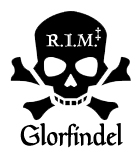
Tuor leads the refugees out of the mountains and then far to the south where the River Sirion passes through Nan-Tathren, the Land of Willows, near the Sea. This far from Morgoth’s domain, Ulmo’s own influence remains strong, so this is where they all camp out and rest up, weary and sorrowful as they are. Though they heal back physically, being hardy First Age Elves, grief stays with them for all that they’ve lost. They feast in memory of Gondolin, they mourn, they sing for its glory and its tragedy. Elf stuff.
Tuor has come a long way since he was a fosterling in Hithlum, then a loner outlaw, then Ulmo’s protégé. Since coming to Gondolin and fulfilling that errand, he’s become a truly great warrior, and a husband, and a dad. During this years-spanning aftermath, he even composes some music for his son, Eärendil, that tells of Ulmo’s arrival on the shores of Middle-earth. He doesn’t sing about himself—remember, he’s humble—but about the Lord of Waters, and the Sea.
And still the Sea calls to him. So he and Idril lead the Gondolindrim down to the Mouths of Sirion, which is where the refugees from Doriath had came not so long before. Among them is Elwing, daughter of Dior, granddaughter of Beren and Luthien, great-granddaughter of Thingol and Melian! I bet she’ll make a fun playmate for Eärendil, too. Both Half-elven kids have been through some rough stuff and have a lot in common.
The Eldar of Beleriand are not so numerous now, but those that have made it this far are at least hanging in there. A new High King of the Noldor is named, now that Turgon is dead: Gil-galad, son of Fingon. Círdan and his own much-reduced people are also nearby.
Morgoth is none the wiser about these important people. All he knows is that he’s just wiped out the last of the great Elf-realms. Bully for him.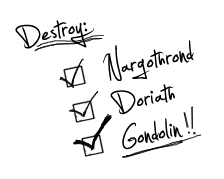 And all it cost him was a few Balrogs, maybe a few dragons, and a buttload of Orcs. No biggie; he’ll make more. The point is, he’s won. Again. So much winning! One wonders if he and his slaves will ever get tired of winning…
And all it cost him was a few Balrogs, maybe a few dragons, and a buttload of Orcs. No biggie; he’ll make more. The point is, he’s won. Again. So much winning! One wonders if he and his slaves will ever get tired of winning…
But Morgoth doesn’t care about the remaining sons of Fëanor. Even at their strongest they never came after him—not really. In fact, their ridiculous Oath has only led them to slaughter other Elves. At this point he’s all too happy to have lost that one Silmaril—look what it’s bought him! Now, who knows if he ever learns about this pathetic little community of mixed Elves down by the seashore near the Bay of Balar, with their silly little ships. If he just waits a bit longer, those sons of Fëanor might even wipe these people off the map, too. Maybe the Eldar problem will solve itself now that they’ve been whittled down.
Especially those damn Noldor!
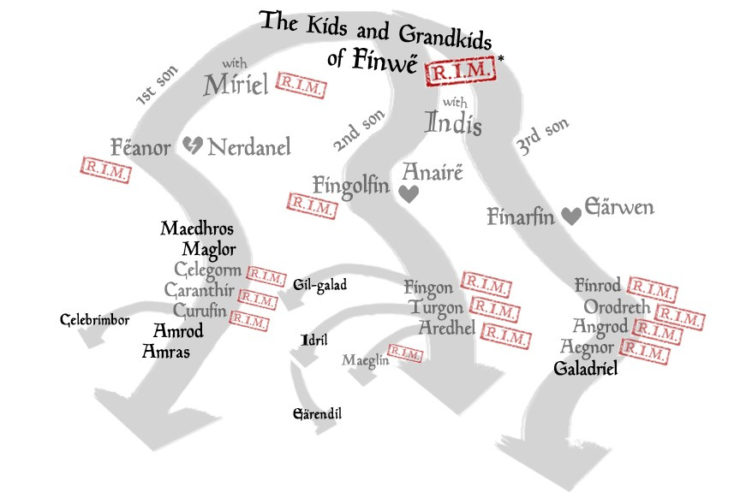
So we cut back to Ulmo. As the most proactive of the Valar, he shows up in Valinor (not something he generally does) and entreats the others, especially his old friend Manwë, King of Arda, to request a forgiveness for the Elves. Hasn’t Morgoth done enough to them already? Nargothrond’s down, Doriath’s kaput, Gondolin’s finished. Stick a fork in the Eldar of Middle-earth. They are done!
But Manwë won’t move. Not yet.
The wise have said that the hour was not yet come, and that only one speaking in person for the cause of both Elves and Men, pleading for pardon on their mis-deeds and pity on their woes, might move the counsels of the Powers; and the oath of Fëanor perhaps even Manwë could not loose, until it found its end, and the sons of Fëanor relinquished the Silmarils, upon which they had laid their ruthless claim.
So we’re not there yet. We need someone to go to Valinor in person.
Meanwhile, Tuor grows older. He’s married to an immortal Elf, to whom a few years mean almost nothing, but he’s looking gray and their son is growing up faster than any Elf. So one day Tuor builds a ship—easy enough with Círdan’s folk around—which he names Eärrámë (possibly just to see how many diaereses he can cram into a single word). Then presumably after a melancholic, not-all-tears-are-an-evil sort of farewell to their son, Tuor and Idril set sail together for the west. Rather, the West, out across the Great Sea and never back into anyone’s line of sight ever again.
Why? Their end is certainly mysterious. Are they seeking Valinor? (Which would, at this time, be in vain.) I don’t think so. Since the moment he first looked upon the Sea, Tuor longed for it, even for “the depths of the realms of Ulmo.” I think he’s seeking retirement with his pal Ulmo, and his wife is on board, too (figuratively and literally). And since no official word ever comes back of the fate of these two, we’re left guessing. The Elves speculate, though, as Elves do, and in their songs they submit that Tuor was “numbered among the elder race” and somehow joined with the Noldor, of which his full-blooded Elven wife was exactly half. But in doing so he was forever sundered from the fate of Men. Tuor broke a lot of molds.
For more of an all-in-one treatment of Gondolin and the Iceberg of Doom that Turgon waited too long to veer from, consider the imminent release of The Fall of Gondolin!
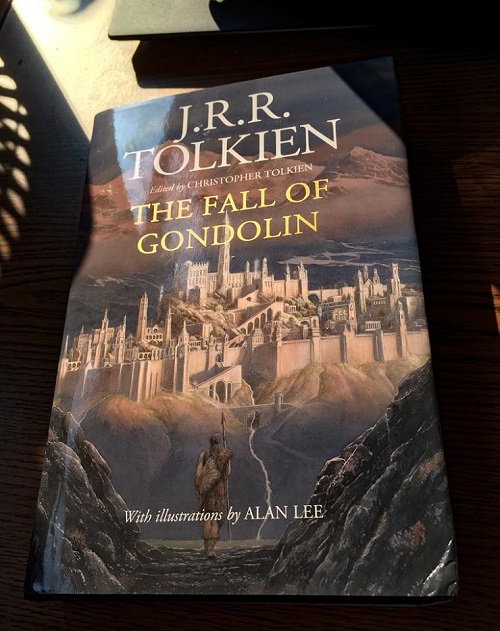
In the next installment, we come at last to the end of the Quenta Silmarillion (though not the book itself) with “Of the Voyage of Eärendil and the War of Wrath.” Front and center will be Tuor and Idril’s kid, not to mention Dior and Nimloth’s kid, a very special ship, and a whole lot of vengeful Valar.
Also….Tulkas SMASH.
Top image from “Ulmo and Tuor” by Daniel Pilla.
Jeff LaSala has so many questions about Ulmo! What are all his powers, his limitations? Does he think about Middle-earth all the time or does he set aside a certain portion of the day? How tall is he and what’s his shoe size? Tolkien geekdom aside, Jeff wrote a Scribe Award–nominated D&D novel, produced some cyberpunk stories, and now works for Tor Books. He is sometimes on Twitter.










